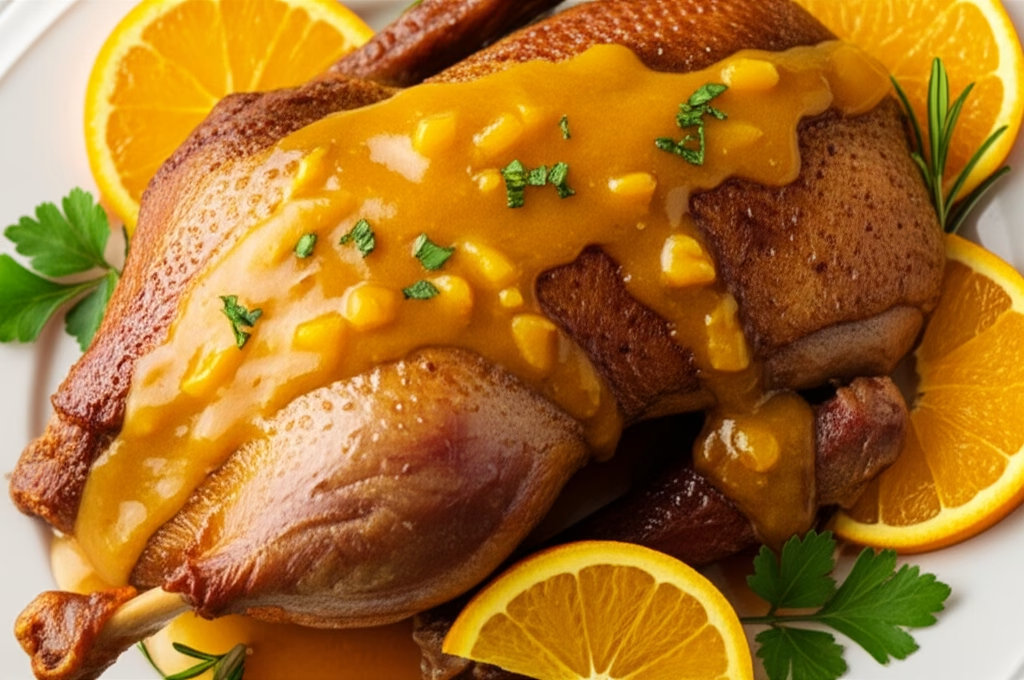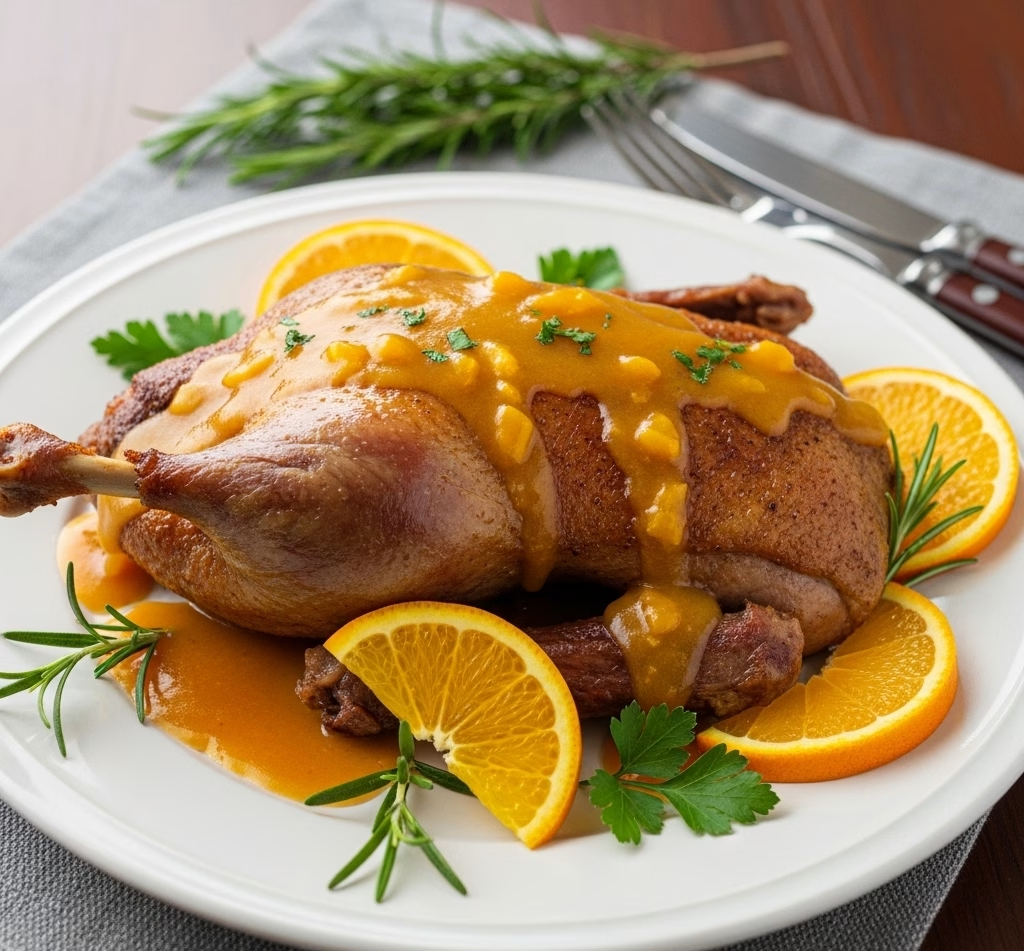Duck à l’Orange (France) is a quintessential French classic that beautifully balances rich, succulent duck with the bright, tangy sweetness of orange sauce.
This iconic dish, often associated with haute cuisine, has captivated gourmets for centuries with its masterful combination of crispy duck skin and citrus-infused reduction. Whether served in a Parisian bistro or a fine-dining restaurant, Duck à l’Orange represents the elegance and depth of French gastronomy. Today, we’ll guide you step by step through making an authentic Duck à l’Orange at home — from rendering the perfect crispy skin to creating a velvety orange sauce infused with Grand Marnier and aromatics.
Table of Contents
Ingredients
For the Duck:
- 1 whole duck (approximately 5 lbs), giblets removed
- Salt (to taste)
- Freshly ground black pepper (to taste)
- 1 tablespoon olive oil
- 1 onion, quartered
- 1 carrot, chopped
- 2 garlic cloves, crushed
- 1 sprig fresh thyme
- 1 bay leaf
For the Orange Sauce:
- 1 cup freshly squeezed orange juice (about 4–5 oranges)
- 1 tablespoon orange zest
- ½ cup chicken or duck stock (preferably homemade)
- ¼ cup white wine vinegar
- ¼ cup sugar
- 2 tablespoons Grand Marnier or Cointreau
- 2 tablespoons unsalted butter (cold)
- Salt and pepper, to taste
Garnish:
- Orange slices or segments (peeled and pith removed)
- Fresh parsley or microgreens (optional)
Serves
4 servings
Step-by-step Instructions
Step 1: Prepare the Duck
- Preheat your oven to 375°F (190°C).
- Rinse the duck under cold water and pat completely dry with paper towels.
- Trim excess fat from the duck’s cavity and score the skin in a crisscross pattern without cutting into the meat.
- Season the entire duck, including the cavity, with salt and pepper.
- Stuff the cavity with the onion, carrot, garlic, thyme, and bay leaf.
Step 2: Render the Fat
- Place a roasting pan or large oven-safe skillet over medium heat.
- Add the olive oil and carefully sear the duck, breast side down, for about 5–7 minutes until the skin starts to crisp and brown.
- Flip and sear the other side for another 5 minutes.
Step 3: Roast the Duck
- Transfer the skillet to the preheated oven or place the duck in a roasting pan.
- Roast for about 1 hour and 15 minutes, or until the internal temperature of the thigh reaches 165°F (74°C).
- Baste the duck with its rendered fat every 20–25 minutes for added crispiness.
- Once done, remove the duck and let it rest on a cutting board for 15 minutes before carving.
Step 4: Make the Orange Sauce
- In a saucepan over medium heat, add vinegar and sugar. Stir until it becomes a golden caramel (about 5 minutes).
- Carefully deglaze with orange juice and whisk continuously.
- Add zest, stock, and Grand Marnier. Let simmer for 10–12 minutes until the sauce reduces by half.
- Whisk in cold butter gradually to thicken and shine the sauce. Season with salt and pepper to taste.
Step 5: Carve and Serve
- Carve the duck: remove the legs and thighs, then the breasts. Slice the breast meat thinly against the grain.
- Arrange slices on a serving platter or individual plates.
- Spoon orange sauce over the duck and garnish with orange segments or zest.

Serving Suggestions
Duck à l’Orange pairs beautifully with:
- Pommes Duchesse or creamy mashed potatoes
- Haricots verts (French-style green beans) sautéed in butter
- Glazed carrots with honey and thyme
- A glass of Pinot Noir or Côte du Rhône
For a rustic French presentation, serve it with crusty bread and a light salad with vinaigrette on the side.
Tips for Perfect Duck à l’Orange
- Dry the duck well – moisture prevents crispy skin.
- Score, don’t pierce – cutting too deep into the meat while scoring will release juices and dry the duck.
- Use fresh orange juice – bottled juice lacks the brightness and complexity needed for the sauce.
- Deglaze the roasting pan – for extra flavor, scrape the browned bits from the pan and add them to your sauce.
- Don’t overcook – duck breast should remain juicy and slightly pink.
- Rest the duck – this step is crucial for retaining moisture.
Healthier Alternatives
While Duck à l’Orange is decadent by design, here are some lighter adaptations:
- Use duck breasts only instead of the whole duck to reduce fat content.
- Trim visible fat and roast on a rack to allow excess fat to drain off.
- Swap the caramelized sugar in the sauce with honey or a low-glycemic sweetener like agave.
- Steam or blanch vegetables instead of roasting them in duck fat.
- Use a citrus glaze made with orange juice, balsamic vinegar, and herbs instead of butter-thickened sauce.
Creative Variations
- Asian twist: Add soy sauce, ginger, and star anise to the sauce for a Mandarin-inspired flavor.
- Cranberry-orange sauce: For a holiday feel, incorporate fresh cranberries into the orange reduction.
- Orange and fennel glaze: Add finely sliced fennel to the sauce for a slightly anise-like undertone.
- Duck leg confit à l’orange: Use confit duck legs and finish with orange glaze instead of whole roast.
- Vegetarian version: Use roasted seitan or tofu and pair it with the same orange sauce.
Common Mistakes to Avoid
- Not scoring the duck skin – it prevents proper fat rendering.
- Cooking at too high a temperature – this can dry out the meat.
- Using bottled orange juice – can result in a flat, overly sweet sauce.
- Skipping resting time – juices will escape and make your duck dry.
- Not basting during roasting – affects crispiness and moisture.
- Over-reducing the sauce – it may become too thick or bitter.
- Using cold duck – always bring it to room temp before roasting.
- Overcrowding the pan – this causes uneven cooking.
- Forgetting to deglaze the pan – you miss out on deep, roasted flavors.
- Using salted butter in the sauce – can make it too salty if you’re not careful.
History of Duck à l’Orange (France)
Duck à l’Orange, or Canard à l’Orange, dates back to the royal kitchens of Renaissance France, although the concept of combining meat with fruit can be traced to even earlier medieval European traditions. During the 16th century, noble households often served roasted meats with citrus glazes, believed to aid digestion and offer a lavish presentation. The pairing of duck—a richly flavored bird—with the bright zest of orange became a symbol of refinement and culinary sophistication.

In the 20th century, Duck à l’Orange became a staple of nouvelle cuisine, a culinary movement that emphasized lighter, more elegant dishes. It appeared frequently in fine-dining menus in Paris and abroad, especially in French restaurants that catered to international clientele. The recipe was further popularized by renowned chefs like Julia Child, who introduced it to American home cooks in the 1960s.
Despite its regal beginnings, Duck à l’Orange remains deeply rooted in French culinary tradition. Today, variations of the dish appear in both rustic countryside kitchens and Michelin-starred establishments. Its timeless appeal lies in the perfect marriage of flavors—gamey richness, citrusy brightness, and a luxurious texture that makes every bite unforgettable.
FAQs about Duck à l’Orange (France)
- What type of duck is best for Duck à l’Orange?
Pekin or Moulard duck are most commonly used due to their tender meat and balanced fat content. - Can I use duck breasts instead of a whole duck?
Yes, pan-seared duck breasts are a quicker alternative and still deliver great results. - What does Duck à l’Orange taste like?
It’s savory and rich with a sweet and tangy citrus glaze, perfectly balancing the flavors. - Can I make it ahead of time?
Yes, you can roast the duck a few hours ahead and gently reheat. Prepare the sauce fresh. - How do I get crispy duck skin?
Properly score and dry the skin, render fat slowly, and baste regularly. - Is Grand Marnier necessary?
It adds depth, but you can substitute with Cointreau or even brandy with extra orange zest. - Can I freeze leftover Duck à l’Orange?
Yes. Freeze the carved duck and sauce separately in airtight containers for up to 2 months. - What sides pair best with this dish?
Roasted vegetables, mashed potatoes, or rice pilaf complement the dish beautifully. - What wine pairs with Duck à l’Orange?
A fruity red wine like Pinot Noir or a medium-bodied Grenache works well. - Is this dish very sweet?
No, the sauce is balanced with acidity and bitterness from zest and vinegar.
Duck à l’Orange (France) is a timeless masterpiece of French culinary tradition that bridges elegance with bold, harmonious flavors. The savory richness of roasted duck paired with the zesty complexity of orange sauce creates a dish that’s both luxurious and accessible with the right technique. Whether you’re preparing it for a romantic dinner, holiday celebration, or as a culinary challenge, this dish is sure to impress. With careful preparation and attention to detail, you can recreate a Michelin-worthy classic in your own kitchen.
Ready to bring the taste of France to your table? Duck à l’Orange awaits — crispy, juicy, citrusy, and unforgettable.


